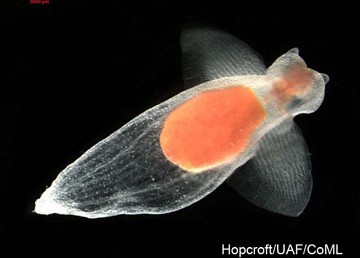—
—
Barrel-shaped body with paddle-like lateral wings; No external gills; Transparent body with orange-red colouration in the tail and horn-like mouth organs; Tentacles and hooks deployed during feeding; Reddish-brown visceral mass is seen through the body wall; Several subspecies and forms recognized, with differing shell shape and differeing polar/subpolar distribution.
An active swimmer while hunting for its shelled pteropod prey, primarily Limacina helicina; Feeding apparatus consists of 3 pairs of buccal cones (finger-like tentacles), 2 clusters of long hooks, and a toothed radula (a chain-saw like tongue) all normally hidden inside the head and body; Feeding apparatus is everted (pushed out) during feeding to extract the prey from their shells; A well-fed animal has a large dark gut.
(From EOL, 21 May 2011)





